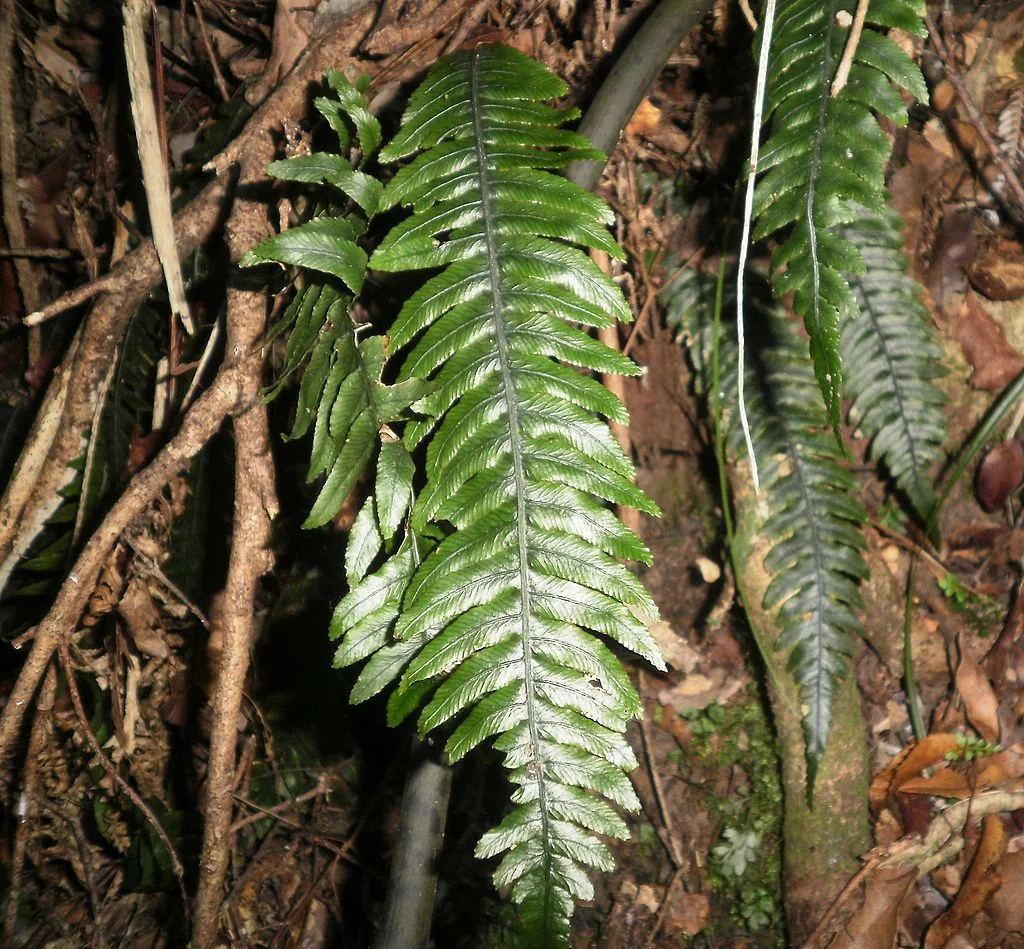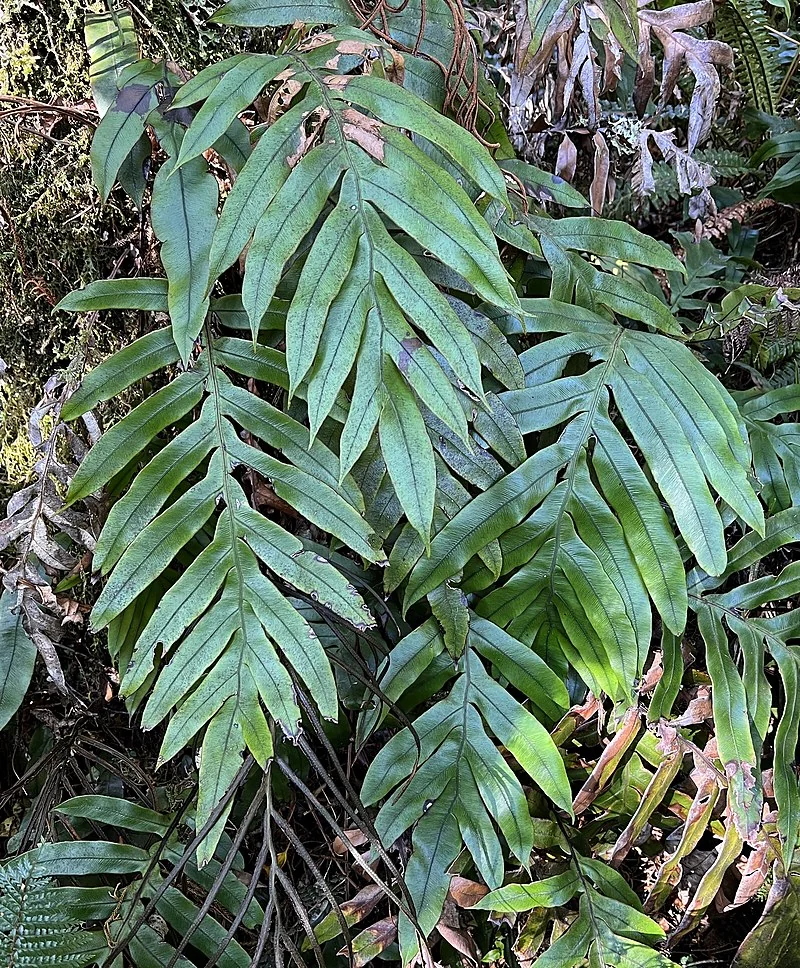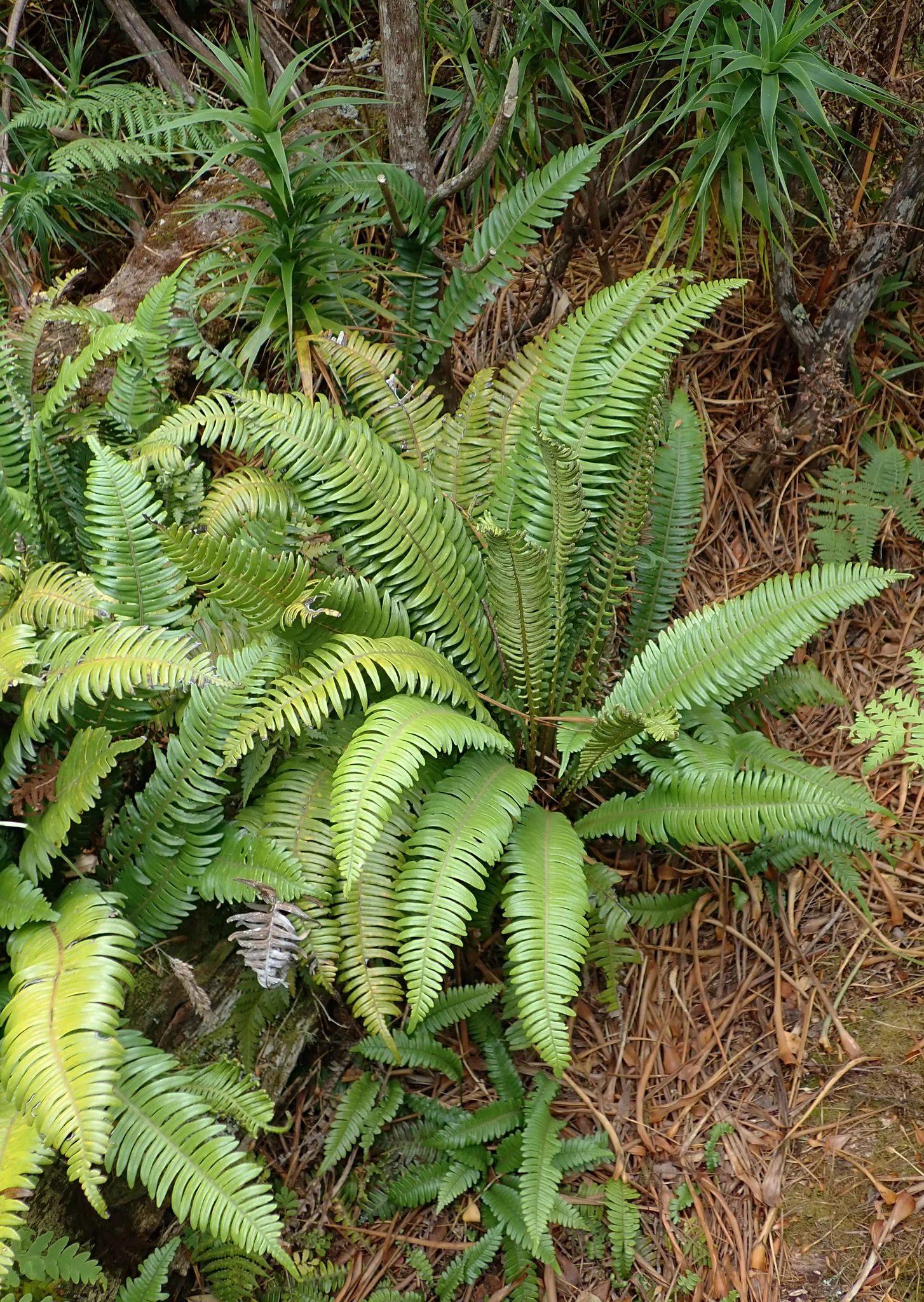
Lance Fern
Austroblechnum lanceolatum
Austroblechnum lanceolatum , commonly known as lance water fern, and by its Māori names nini and rereti, is a medium-sized fern belonging to the family Blechnaceae. Indigenous to Australia and New Zealand, it can also be found in Samoa and Fiji. This distinctive species features tufted, dimorphic fronds with separate sterile and fertile forms. The fronds typically range from 12-65cm long and 20-100mm wide. Emergent fronds are green, often with a pinkish tinge, while mature fronds develop into dark green coloration, frequently tinged with maroon. Found in shaded riparian habitats along streams and waterfalls, this adaptable fern forms an important component of New Zealand's native forest understory.

Plant Description
Austroblechnum lanceolatum (kiokio; syn. Blechnum chambersii ) is a robust fern forming spreading colonies with lanceolate fronds to c. 1 m. Narrow fertile fronds rise above the broader sterile fronds, creating layered texture.
Quick Facts
| Common Names | Lance Fern, Lance Water Fern, Nini, Rereti |
|---|---|
| Scientific Name | Austroblechnum Lanceolatum |
| Family | Blechnaceae (Hard fern family) |
| Growth Form | Compact ground fern with erect rhizomes |
| Height | 12-65cm tall (frond length) |
| Spread | 30-50cm forming small rosettes |
| Water Needs | High - requires consistent moisture |
| Light | Deep to partial shade - no direct sun |
| Frost Tolerance | Good - hardy native species |
| Salt Tolerance | Low - inland forest species |
| Growth Rate | Slow to moderate establishment |
| Lifespan | Long-lived perennial (50+ years) |
| Fronds | Dimorphic: sterile and fertile forms differ, 20-100mm wide |
| Distinctive Features | Lance-shaped fronds, pinkish new growth, dark green mature |
| Conservation Status | Not Threatened |
| Distribution | North Island, South Island, Stewart Island, Chatham Islands |
| Habitat | Shaded streamside, waterfall spray zones, forest understory |
| Elevation Range | Coastal to montane elevations |
| Ecological Role | Host for endemic moth Batrachedra litterata |
Climate Best Suited to
Temperate, humid climates from coastal to montane sites; tolerant of light frost with consistent soil moisture.
Regional Suitability
| City | Climate Suitability |
|---|---|
| Whangārei | Ideal |
| Auckland | Ideal |
| Hamilton | Ideal |
| Tauranga | Ideal |
| Rotorua | Ideal |
| Gisborne | Ideal |
| New Plymouth | Ideal |
| Napier | Ideal |
| Whanganui | Ideal |
| Palmerston North | Ideal |
| Wellington | Ideal |
| Nelson | Ideal |
| Christchurch | Ideal |
| Dunedin | Ideal |
| Invercargill | Ideal |
Natural Habitat
Widespread from lowland to montane forest, this lance‑fronded fern favours damp, free‑draining banks, seepage lines and stream edges where filtered light and high humidity prevail. It often occupies semi‑open glades or track margins, forming groundcover beneath mānuka-kānuka and mixed broadleaf canopy.
Plant Conservation
The conservation status of Austroblechnum lanceolatum is "Not threatened." This fern species is widespread in New Zealand, Australia, and Pacific islands. It is commonly found in shaded riparian habitats, damp rock walls, limestone areas, and cave entrances, preferring consistently moist, cool, and humid microclimates.
Growing Requirements
Soil
Moist, well-drained soil rich in humus. Often grows on rocky substrates or clay banks near water.
Light
Deep to partial shade. Avoid direct sun which will scorch the fronds.
Water
High moisture requirement. Does not tolerate drying out. Ideal for streamsides.
Planting Guide
Site Selection
Choose a constantly damp, shady spot, such as a gully, stream bank, or the south side of a building. Austroblechnum lanceolatum (Lance Fern) loves high humidity. It is excellent for planting near waterfalls or ponds where it can benefit from spray and moist air.
Ecology
Spreading rhizomes knit loose forest soils and stabilise damp banks, while dense fronds shade the ground and suppress weeds. The clumping habit creates cool refuges for invertebrates and protects amphibious stream margins during summer low flows.
Uses
Versatile groundcover for woodland paths, riparian buffers and under light shrub canopies. Mass plant to form a durable, evergreen carpet that unifies shaded beds and frames boulders or logs.
Landscaping Ideas
Layer beneath tree ferns and mingle with fine sedges such as Carex to contrast textures. On slopes, plant in a staggered grid to control erosion while keeping a naturalistic rhythm.
Seasonal Care
Summer
Mulch deeply and irrigate during extended dry spells to prevent frond scorch.
Winter
Protect young plants from severe frost with a light mulch and overhead canopy.
Top up leaf‑litter mulch annually and feed lightly in spring if growth is pale or thin.
Pruning
Maintenance
Remove dead or tattered fronds at the base to maintain a neat appearance. As it often grows in colonies, thinning may be required to prevent overcrowding, though it naturally forms attractive drifts.
How to Grow Lance Fern
Lance Fern grows best when you match its natural habitat: prepare well-drained soil, get the light right, water steadily, and protect from extremes during establishment. Dig wide planting holes, set the crown at original depth, water to settle, and mulch with coarse organic matter to conserve moisture while keeping the stem base dry. Feed lightly in spring; heavy nitrogen is unnecessary and can weaken growth.
Seed
Sow fresh, viable seed on a free-draining mix, cover lightly with fine grit, and keep evenly moist in bright light out of harsh sun. Germination timing varies; prick out once roots hold the media and harden off gradually.
Division
Where the species permits, divide robust clumps in early spring as new growth begins. Replant divisions with several shoots into fresh mix, water thoroughly, and maintain steady moisture until re"established.
Cuttings
For shrubs and many perennials, strike semi-hardwood cuttings in late spring to summer in a coarse, free-draining propagation mix under gentle bottom heat and high humidity. Reduce leaf area, ventilate progressively as roots develop, and pot on before planting out.
Aftercare
Maintain an open mulch, irrigate during drought in the first season, and prune or tidy according to the species to build a resilient framework. Adjust shade, wind exposure and watering to prevent stress, and refresh mulch annually for long-term performance.
Pests and Diseases
Common Problems and Solutions
Generally trouble‑free; slugs and snails may graze tender croziers. Frond browning usually indicates drought or excess sun-shift to brighter shade and improve irrigation during summer.
Cultural Significance
Traditional Uses and Values
Lance Fern holds cultural significance in Māori tradition, known by the names nini and rereti. While specific traditional uses for Austroblechnum lanceolatum are not extensively documented in modern literature, it forms part of the broader group of native ferns that were valued in Māori culture.
Many ferns, including species in the Blechnum family, were traditionally used in rongoā (Māori medicine) and as important components of forest ecology. The distinctive dimorphic fronds and streamside habitat of Lance Fern would have made it a familiar sight to early Māori communities, particularly those living near rivers and streams.
In contemporary horticulture, Lance Fern serves as an excellent representative of New Zealand's endemic fern flora. Its successful cultivation helps preserve genetic diversity and provides opportunities for education about the country's unique botanical heritage. The species demonstrates the specialized adaptations of New Zealand's native plants to particular microhabitats.
Bonus Tip
Expert Growing Advice
In heavy soils, plant on shallow mounds and keep crowns just above finished level to avoid winter wet. A thin gravel collar around the crown sheds splash and reduces rot after prolonged rain.







